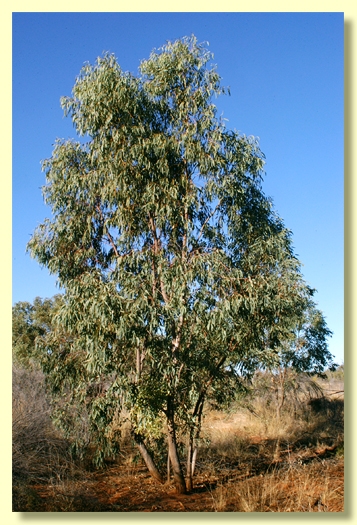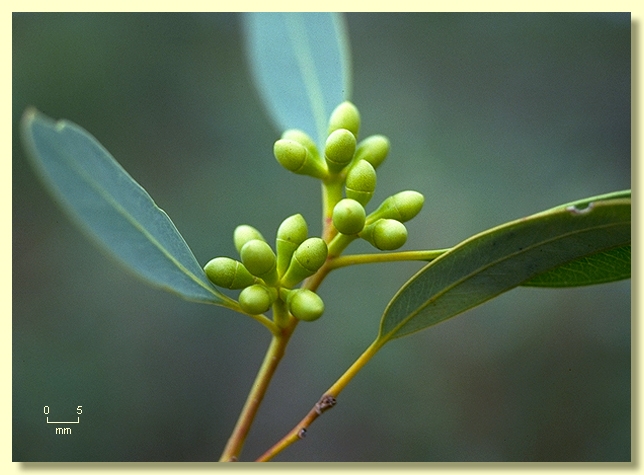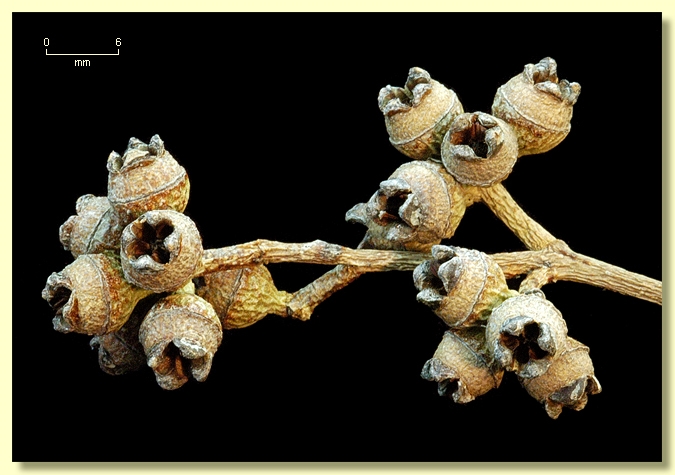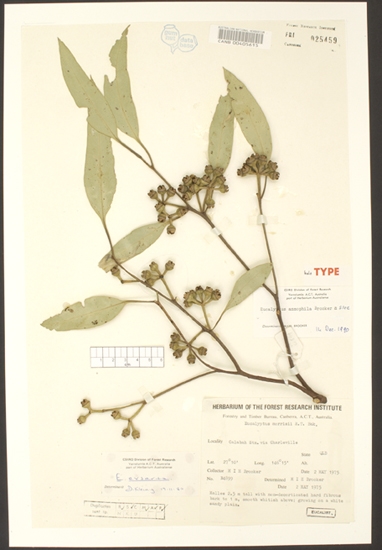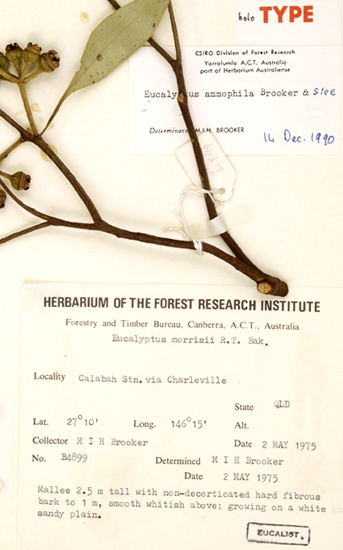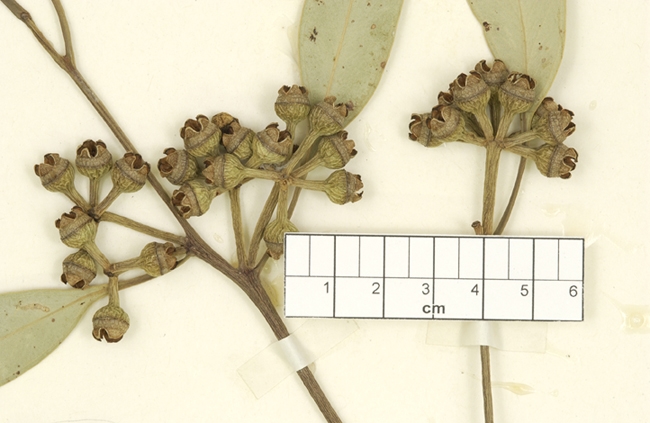Euclid - Online edition
Eucalyptus ammophila
Eucalyptus | Symphyomyrtus | Exsertaria | Phaeoxylon
Mallee to 6 m tall, rarely a small multistemmed tree. Forming a lignotuber.
Bark rough, usually to the base of the branches, sometimes only on the lower trunk, fibrous, grey-brown. Upper trunk and branches with grey to grey-brown over orange to bronze smooth bark.
Juvenile growth (coppice or field seedlings to 50 cm): stem square in cross-section, sometimes with a small wing on the edges; juvenile leaves shortly petiolate, alternate, ovate to broadly lanceolate, 6–8.5 cm long, 2.2–3.6 cm wide, dull, grey-green to light green.
Adult leaves alternate, petiole 0.7–2.5 cm long; lanceolate, 6–13.5 cm long, 1.3–2.5(3) cm wide, base tapering to petiole, concolorous, normally dull, usually blue-green at first, maturing to green, side-veins acute, less than 45° to midrib, sparsely to moderately reticulate, intramarginal vein parallel to and remote from margin, oil glands island.
Inflorescence axillary unbranched, peduncles 0.5–1.2(1.5) cm long, buds 7(–11) per umbel, pedicellate (pedicels ca. 0.2 cm long. Mature buds ovoid (ca. 0.8 cm long, 0.5 cm wide), yellow or creamy, smooth, scar present, operculum conical (ca. 0.6 cm long), stamens erect, anthers cuboid to oblong, versatile, dorsifixed, dehiscing by longitudinal slits (non-confluent), style long, stigma tapered, locules 4(5), the placentae each with 6 vertical ovule rows. Flowers white.
Fruit pedicellate (pedicels 0.3–0.5 cm long), hemispherical, 0.3–0.5 cm long, 0.6–0.9 cm wide, disc raised and vertical to oblique, rarely either convex or concave, valves 4(5), strongly exserted.
Seeds dark brown to black, 1–1.5 mm long, pyramidal or cuboid, dorsal surface usually pitted, edge sharply toothed, hilum terminal.
Cultivated seedlings (measured at ca node 10): cotyledons oblong; stems square in cross-section; leaves always petiolate, opposite for 3 to 7 nodes then becoming alternate, lanceolate, 7–14 cm long, (0.5)1–3 cm wide, base tapering, apex pointed, dull, grey-green to green, discolorous.
Flowering time unknown.
A mallee preferring the red or orange sandplains and only known from localities in central and southern Queensland, from south-east of Charleville on Calabah Station and eastwards to the Charleville–Bollon road, also in the Lochnagar, Yalleroi and Jericho area. Further north disjunct stands occur in the White Mountains area just W of Pentland and on the Cobbold sandstone south-west of Forsayth. A red gum with persistent rough bark and single-coated seed, Eucalyptus ammophila is further distinguished by its mallee habit, fruit with a steeply ascending disc and prominently exserted valves and the lanceolate to ovate juvenile leaves.
Eucalyptus ammophila belongs to a group of red gums that is distinguished by having rough bark, buds with the stamens mostly erect, fruit where the disc is united to the ovary roof and by the dark brown to black, toothed, cuboid to pyramidal single-coated seed. This group has 6 taxa and is distributed from central New South Wales north to New Guinea. They are E. brassiana, E. lockyeri subsp. lockyeri, E. lockyeri subsp. exuta, E. ammophila, E. exserta and E. morrisii. Within this group E. ammophila is closest to E. exserta and is distinguished by having slightly broader juvenile leaves (0.3–1.6 cm wide in E. exserta but 1–3 cm wide in E. ammophila) and by its preference for the deep red to orange sand as opposed to E. exserta, which prefers the stony hills and rises. It is also very similar to E. lockyeri subsp. exuta and is distinguished by its mallee habit and by its preference for growing on sand plains. (E. lockyeri subsp. exuta is normally a tree of the hills.) E. lockyeri subsp. lockyeri is distinguished by having glaucous adult leaves, buds and fruit (E. ammophila not glaucous). E. brassiana is normally a well formed tree from North Queensland with much larger broadly lanceolate to ovate juvenile leaves. E. morrisii is from central New South Wales and can be distinguished by having 3-budded umbels (always 7-budded or more in E. ammophila).
Eucalyptus ammophila may also be confused with two other rough-barked red gums from the closely related series Erythroxylon. They are E. chloroclada and E. terrica. Both E. chloroclada and E. terrica are small to medium-sized trees with thin, flaky, brown to orange rough bark, while E. ammophila is usually a mallee with harder and more persistent brown rough bark.
Eucalyptus ammophila: Greek ammos, sand and phila, loving, referring to the preference for this species to grow on sandplains.

